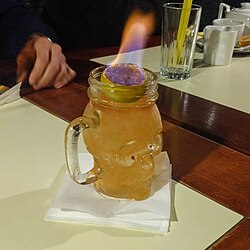History
Legend has it that Donn Beach originally concocted the zombie to help a hung-over customer get through a business meeting. [3] [4] The customer returned several days later to complain that he had been turned into a zombie for his entire trip. Its smooth, fruity taste works to conceal its extremely high alcoholic content. Don the Beachcomber restaurants limited their customers to two zombies apiece because of their potency, which Beach said could make one "like the walking dead." [5] [6]
According to the original recipe, the zombie cocktail included three different kinds of rum, lime juice, falernum, Angostura bitters, Pernod, grenadine, and "Don's Mix", a combination of cinnamon syrup and grapefruit juice. [7]
Beach was very cautious with the recipes of his original cocktails. His instructions for his bartenders contained coded references to ingredients, the contents of which were only known to him. [8] Beach had reason to worry; a copy of the zombie was served at the 1939 New York World's Fair by a man trying to take credit for it named Monte Proser (later of the mob-tied Copacabana). [9] [10] [11]
Beach's original recipes for the zombie and other tiki drinks have been published in Sippin' Safari by Jeff "Beachbum" Berry. Berry researched the origins of many tiki cocktails, interviewing bartenders from Don the Beachcomber's and other original tiki places and digging up other original sources. Sippin' Safari details Beach's development of the zombie with three different recipes dating from 1934 to 1956. [4]
The zombie was occasionally served heated (a drink more commonly known today as the I.B.A. hot zombie), as outlined by the Catering Industry Employee (CIE) journal: "Juice of 1 lime, unsweetened pineapple juice, bitters, 1 ounce heavily bodied rum, 2 ounces of Gold Label rum, 1 ounce of White Label rum, 1 ounce of apricot-flavored brandy, 1 ounce of papaya juice" [12]
The cocktail is named in the lyrics for the song "Haitian Divorce" on the 1976 album The Royal Scam by Steely Dan. [13]
Options
One variation on the recipe is to keep the base of the various rum, brandy, and Bacardi varieties and substitute orange, pineapple, lemon, and grenadine juices for the pineapple and papaya juices. [17] [18] Another version is based on giving up brandy and substituting juices from sweeter flavors to more citrusy ones like lemon, pineapple and papaya.
The zombie voodoo cocktail is a variation of the classic zombie cocktail. [19] It contains unique ingredients like absinthe and blackberries that give it a distinctive flavor. [20] [21] This version retains the tropical base of the original zombie, but takes on a slightly different flavor thanks to the added ingredients.
Tiki culture influence
Due to the popularity of the cocktail during the tiki craze, from the 1930s, and the fact that Beach kept his recipe secret and occasionally altered it, there are many variations of the zombie served at other restaurants and bars (some tasting nothing like the original cocktail). The word zombie also began to be used at other tiki themed establishments, such as at the Zombie Hut and Zombie Village. [22] [23]
Trader Vic also listed a recipe for the zombie in his 1947 Bartender's Guide. [24] Other competitors created drinks linked to the zombie. At Stephen Crane's Chicago Kon-Tiki Ports restaurant they featured a drink on the menu called The Walking Dead: "Makes the dead walk and talk. For those who want immediate action – meet the first cousin to the famous 'zombie'. Demerara 151 rum. 90¢." [25]
This page is based on this
Wikipedia article Text is available under the
CC BY-SA 4.0 license; additional terms may apply.
Images, videos and audio are available under their respective licenses.


